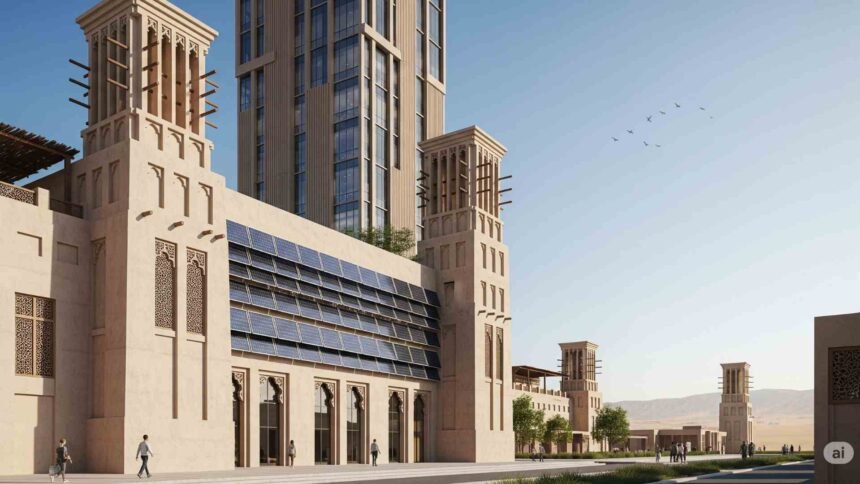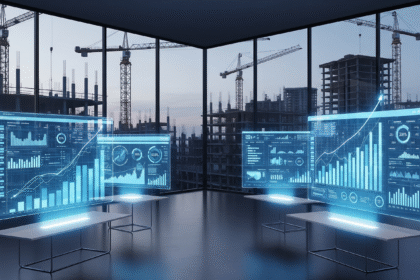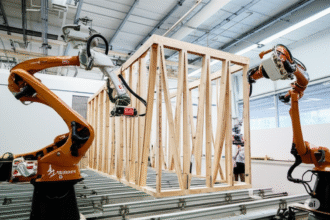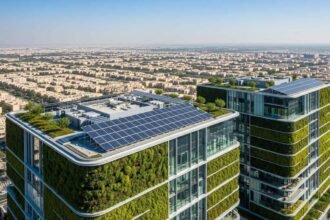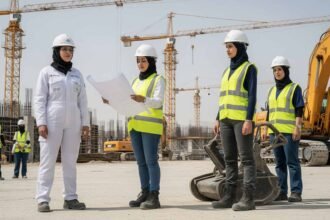The United Arab Emirates (UAE) stands as a global beacon of architectural innovation, where tradition and modernity intertwine seamlessly. From its origins as a collection of modest fishing villages to its current status as a hub of global commerce and tourism, the UAE’s architectural landscape reflects a journey of ambition, cultural pride, and forward-thinking design.
A Legacy of Tradition
Traditional UAE architecture was shaped by the region’s harsh desert climate and rich cultural influences. Windtowers, known as barjeel, were a hallmark of Emirati design, providing natural ventilation long before air conditioning became commonplace. These tall, square structures channeled cool air into homes while expelling hot air, a practical solution to the desert’s high temperatures and humidity. Courtyard houses offered privacy and shade, aligning with societal values of modesty and community. Materials like coral stone, palm fronds, and mud-brick (areesh) were chosen for their insulating properties, reflecting the ingenuity of early builders.
These structures were not merely functional but also embodied the Islamic, Arabian, and Persian cultural heritage of the region. Intricate geometric patterns, arches, and domes—hallmarks of Islamic architecture—adorned buildings, emphasizing both aesthetic beauty and environmental adaptation. For example, the Al Fahidi district in Dubai, with its reconstructed barjeel and coral-walled houses, preserves this vernacular architecture as a cultural hub, showcasing the UAE’s historical identity.
The Dawn of Modernization
The architectural transformation of the UAE began in the 1960s, catalyzed by the discovery of oil and the vision of its leaders. In 1959, Sheikh Rashid bin Saeed Al Maktoum, the former ruler of Dubai, commissioned British architect John R Harris to create Dubai’s first town plan. This marked the beginning of a shift towards modern architecture, with low- and mid-rise buildings that symbolized the nation’s growing ambitions. The Dubai World Trade Centre, completed in 1979, was a landmark project, standing as the tallest tower in the region for many years. Its hexagonal facade, inspired by historic fort designs, used a double facade to reduce energy consumption, blending modern engineering with traditional aesthetics.
By the late 1980s and early 1990s, glass towers became a defining feature of the UAE’s skyline, particularly in Dubai, reflecting the country’s economic boom. These structures, while heavily westernized, retained distinct Emirati cultural elements, influenced by Islamic design principles. The economic prosperity fueled by oil wealth allowed the UAE to attract international architects, who collaborated with local firms to create buildings that merged global styles with regional needs.
Blending Heritage with Modernity
Today, UAE architecture is a masterful blend of tradition and innovation, with iconic structures that have become global landmarks. The Burj Khalifa, the world’s tallest building at 829.8 meters, exemplifies this fusion. Designed by Adrian Smith of Skidmore, Owings & Merrill, its triple-lobed base is inspired by the desert flower Hymenocallis, and its stepped spiral design reflects traditional Islamic architecture. The Burj Al Arab, often compared to the Sydney Opera House, features a steel frame and Teflon-fibreglass sail that symbolizes luxury while nodding to traditional Arabian motifs. Opened in 1999, it stands as a beacon of Dubai’s ambition and cultural pride.
In Abu Dhabi, the Sheikh Zayed Grand Mosque is a masterpiece that combines traditional Arabic design with global influences. Construction began in 1996, using materials like marble, stone, gold, and ceramics sourced from around the world. Its 82 marble domes and reflective pools create a serene yet majestic space, embodying the UAE’s commitment to cultural heritage. Similarly, the Louvre Abu Dhabi, designed with a geometric dome that filters sunlight like traditional mashrabiya screens, reinterprets historical design for a modern context. Qasr Al Watan, another Abu Dhabi landmark, uses glass and steel to reinterpret historic motifs, creating a dialogue between past and present.
These projects demonstrate how the UAE integrates traditional elements—such as geometric patterns, mashrabiya screens, and Persian arches—into contemporary designs. Even modern glass facades often nod to the geometric patterns found in historic forts, ensuring that the UAE’s architectural identity remains distinct.
Sustainability and Innovation
Sustainability has become a cornerstone of modern UAE architecture, drawing inspiration from traditional techniques while embracing cutting-edge technology. Masdar City in Abu Dhabi is a pioneering example, designed to be a zero-carbon, zero-waste city. It incorporates wind tunnels, solar power, and angled rooftops for shade, echoing the climate-responsive designs of traditional barjeel. The Museum of the Future in Dubai, with its calligraphy-inspired structure and self-cleaning solar panels, is another testament to this approach. Its energy-efficient systems reduce air conditioning needs, a critical consideration in the UAE’s hot climate.
Modern materials like recycled steel, smart glass, and local gypsum are used to create decorative screens that reduce solar gain by up to 60%, mirroring the insulating properties of traditional coral stone and mud-brick. Cooling innovations, such as double-glazed glass, automated shades, and AI-driven ventilation systems, further enhance energy efficiency, cutting air conditioning use by up to 40%. Projects like The Sustainable City in Dubai and Al Marjan Island, which focus on coral reef restoration and zero-waste resorts, highlight the UAE’s commitment to sustainable development.
The collaboration between international architects, such as Norman Foster for Masdar City and Zaha Hadid for the Bee’ah Headquarters, and local firms ensures that global styles—like Japanese minimalism or Parisian curves—are adapted to regional needs, such as mashrabiya-inspired screens and souk-like mall layouts.
Recent Developments
Recent projects continue to push the boundaries of this architectural fusion. Reem Hills on Al Reem Island in Abu Dhabi is an exclusive gated community offering villas, townhouses, and apartments with designs inspired by nature. Featuring spacious layouts, lush greenery, and views of mangroves and beaches, it blends modern luxury with the UAE’s natural heritage. The Mallside Residence & Hotel in Dubai, part of the Curio Collection by Hilton, is a mixed-use development with an 18-floor tower that combines luxury living with smart home technologies. Its floor-to-ceiling glass, wood, concrete, and marble interiors are connected to Dubai Hills Mall via a bridge, reflecting a modern lifestyle rooted in community.
The Royal Development Company (RDC), through its subsidiary Royal Architect Project Management (RAPM), has played a significant role in managing over 60 projects globally. RDC’s 15-year expertise emphasizes heritage-inspired designs and smart urban planning, ensuring that new developments align with the UAE’s cultural and environmental goals.
Future Trends and Policies
Looking ahead, UAE architecture is set to embrace adaptive, earth-friendly buildings and minimalistic designs that promote modernity, wellness, and self-expression. The National Policy for Preserving the Modern Architectural Heritage of the UAE, launched in December 2024, underscores the country’s commitment to safeguarding its architectural legacy while fostering innovation. This policy aims to establish a comprehensive national vision for modern architectural heritage, ensuring that future developments continue to honour the past.
Cultural heritage and contemporary fusion remain key trends shaping the UAE’s skyline. Architectural designs that blend traditional Emirati elements with modern aesthetics are gaining prominence, as seen in projects like the Etihad Towers and Ferrari World, where futuristic curves meet cultural motifs. The UAE’s focus on sustainability is also evident in experimental projects like Mars Science City, which tests habitats for desert living and potential off-world colonies, reflecting the nation’s forward-thinking vision.
| Project | Location | Key Features | Heritage Elements | Modern Innovations |
| Burj Khalifa | Dubai | World’s tallest building, 829.8m | Hymenocallis flower-inspired base, Islamic stepped spirals | Glass and steel construction, energy-efficient systems |
| Sheikh Zayed Grand Mosque | Abu Dhabi | 82 marble domes, reflective pools | Traditional Arabic design, global materials | Advanced lighting and cooling systems |
| Louvre Abu Dhabi | Abu Dhabi | Geometric dome, cultural hub | Mashrabiya-inspired light filtering | Smart glass, sustainable design |
| Masdar City | Abu Dhabi | Zero-carbon, zero-waste city | Wind tunnels inspired by barjeel | Solar power, angled rooftops |
| Museum of the Future | Dubai | Calligraphy-inspired structure | Islamic calligraphy motifs | Self-cleaning solar panels, AI ventilation |
| Reem Hills | Abu Dhabi | Nature-inspired villas and townhouses | Natural motifs, community spaces | Smart home technologies, sustainable materials |
| Mallside Residence & Hotel | Dubai | Mixed-use luxury tower | Community-focused design | Smart glass, energy-efficient systems |
UAE architecture is a dynamic field that successfully balances respect for heritage with the drive for modern innovation. Through iconic landmarks like the Burj Khalifa and Sheikh Zayed Grand Mosque, sustainable projects like Masdar City, and forward-thinking policies, the UAE continues to shape its identity as a leader in architectural design. Here, the past informs the future, and tradition meets progress, creating a skyline that is both timeless and visionary. As the UAE continues to evolve, its architecture will remain a testament to its ability to honor its roots while reaching for new heights.


